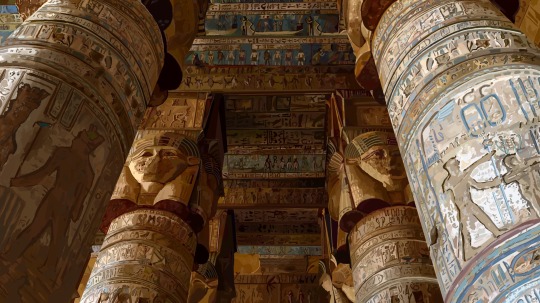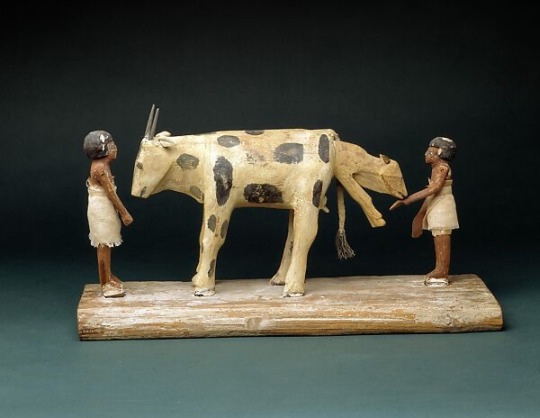#ancient egypt art
Explore tagged Tumblr posts
Text

Aset with baby Heru 🧡 Dua Aset! Dua Heru-sa-Aset!
Aset is one of my main deities and yet, I never draw Her! So, I decided to change that :)
I associate Heru with the color blue amongst others hence the eyes being blue, and I associate Aset with yellows/golden tans and purples/soft violets but I thought Her colors would look better in the background rather than on Her. I also wanted little Heru's eyes to match Aset's wings. I hope it looks alright 💙
Commissions are open and are very helpful ahead of the Holiday season as I have a dog who just had TPLO surgery on one leg and has to get his second leg done after recovering from this one, and it is a pricy surgery. Send me a message if you'd like a commission, and a proper commission price sheet is coming soon 🧡
#kemetic#kemeticism#aset#horus#heru#heru sa aset#isis goddess#kemetic fandom#kemetic gods#art#ancient egypt#egypt art#ancient egypt art#my art#paganism#pagan#pagan art#devotional art#dua aset#dua heru#dua heru sa aset
53 notes
·
View notes
Text

I know this isn't ninjago guys but I finished this 17 hour painting for my art class and I was proud of it so...enjoy.
I love Egypt fun fact about me. :) [ID: a detailed, realistic painting of the hathor columns at the dendera temple complex in dendera, egypt. /end ID]
#my art#art#egypt#egyptian#egyptology#egyptian art#ancient egypt#antiquity#ancient art#ancient egyptian#painting#digital painting
151K notes
·
View notes
Photo
@themousefromfantasyland


Anpu and Bata (Tale of Two Brothers)
2K notes
·
View notes
Text

This is what hieroglyphs and figures in ancient Egyptian temples looked like before their colors faded. They were recreated using a polychromatic light display at the Metropolitan Museum of Art, New York, following thorough research.
48K notes
·
View notes
Text









Check out the new product 🔥🔥 Sunset Over the Pyramids
This striking design showcases the word "EGYPT" in bold, elegant font, placed beneath a detailed silhouette of the pyramids, set against a breathtaking sunset gradient. The warm hues and intricate details evoke the majestic beauty and timeless allure of ancient Egypt. Perfect for history buffs, adventurers, and anyone enchanted by the wonders of the past.
#Egyptian design#pyramids silhouette#sunset gradient#ancient Egypt art#pyramids#egypt#egyptian#cairo#travel#pyramid#ancient#pharaoh#giza#ancient egypt#vintage#sphinx#vacation#history#retro#desert#EgyptianVibes#PyramidsOfGiza#SunsetArt#HistoricalDesign#CulturalHeritage#BoldTypography#AdventureWear#AncientEgypt#TravelInspired#TimelessBeauty
0 notes
Text

Carnelian frog amulet, Egypt, 18th Dynasty, 1540-1296 BC
from The Cleveland Museum of Art
8K notes
·
View notes
Text
So, I saw this image on Facebook, and it was supposedly showing what Queen Nefertiti would have looked like in real life:

Now, I thought this AI generated garbage was just truly terrible on a number of levels; first off, she looks wayyyyyy too modern - her makeup is very “Hollywood glamour”, she looks airbrushed and de-aged, and as far as I’m aware, Ancient Egyptians didn’t have mascara, glitter-based eyeshadows and lip gloss. Secondly, her features are exceptionally whitewashed in every sense - this is pretty standard for AI as racial bias is prevalent in feeding AI algorithms, but I genuinely thought a depiction of such a known individual would not exhibit such euro-centric features. Thirdly, the outfit was massively desaturated and didn’t take pigment loss into consideration, and while I *do* like the look of the neck attire, it's not at all accurate (plus, again, AI confusion on the detailing is evident).
So, this inspired me to alter the image on the left to be more accurate based off the sculpture’s features. I looked into Ancient Egyptian makeup and looked at references for kohl eyeliner and clay-based facial pigment (rouge was used on cheeks, charcoal-based powder/paste was used to darken and elongate eyebrows), and I looked at pre-existing images of Nefertiti (namely other reconstructions). While doing this, I found photos of a 3D scanned sculpture made by scientists at the University of Bristol and chose to collage the neck jewellery over the painting (and edited the lighting and shadows as best as I could).

Something I see a lot of in facial recreations of mummies is maintaining the elongated and skinny facial features as seen on preserved bodies - however, fat, muscle and cartilage shrink/disappear post mortem, regardless of preservation quality; Queen Nefertiti had art created of her in life, and these pieces are invaluable to developing an accurate portrayal of her, whether stylistic or realistic in nature.

And hey, while I don't think my adjustments are perfect (especially the neck area), I *do* believe it is a huge improvement to the original image I chose to work on top of.
I really liked working on this project for the last few days, and I think I may continue to work on it further to perfect it. But, until then, I hope you enjoy!
Remember, likes don't help artists but reblogs do!
#Nefertiti#Queen Nefertiti#Ancient Egypt#Facial Reconstruction#art#artist#digital artist#historical#history#historical figure#ancient egyptians#artistic interpretation#historial facial reconstruction#Neferneferuaten#Queen Neferneferuaten Nefertiti#illustration#digital art#digital illustration
16K notes
·
View notes
Text

I can’t tell you how much I love this artwork from ancient Egypt (the Middle Kingdom). People have been raising cattle and practicing animal husbandry for so long, that there is something almost inherently human about this scene.
Everyone in the field of veterinary medicine or agriculture knows the feeling of staying up late with a laboring animal trying to make sure both mom and baby are okay. Delivering a calf is often physically and emotionally exhausting work that takes enormous patience and learned skill. It requires a unique balance of physical strength and gentleness to do correctly. There is no feeling quite like getting that baby out and everyone is okay. I’m certain ancient people must have felt the same way, and I wonder if the artist knew this feeling firsthand. I wonder if those humans depicted were people the artist knew, if the cow and calf maybe were as well.
28K notes
·
View notes
Text

Before there was Moo Deng, there was William.
This little blue hippopotamus, known affectionately as William, has been a fan favorite at The Metropolitan Museum of Art for over a century. Dating back to Egypt’s Middle Kingdom (c. 1961–1878 BCE), William was likely placed in tombs to offer protection in the afterlife.
His bright faience glaze and lotus decorations connect him to the Nile’s waters—but don’t let his charm fool you! Ancient Egyptians knew that hippos were both revered and feared, making William a powerful symbol. He epitomizes the Egyptian craftsmanship of the era.
Take a closer look at William on JSTOR.
Image: Hippopotamus (William), ca. 1961–1878 B.C. Faience. The Metropolitan Museum of Art.
#jstor#the metropolitan museum of art#open access#hippopotamus#egypt#ancient egypt#middle kingdom#art#faience
5K notes
·
View notes
Text

Artist's Sketch of a Sparrow (ca. 1479–1458 B.C.)
Reign: Joint reign of Hatshepsut and Thutmose III - The Met
7K notes
·
View notes
Text

Gold swivel ring featuring an amethyst frog, from the New Kingdom period of Egypt, dating between 1550-1229 BC.
#new kingdom#ancient egypt#egyptology#egyptian#egypt#frog art#frog#amethyst#purple and gold#gold jewelry#gold rings#egyptian history#egyptian archaeology#egyptian art#antique#antiquities#toya's tales#style#toyastales#toyas tales#art#ring#antique jewelry#world history#artifact#art history#swivel ring#amphibians#fashion#accessories
3K notes
·
View notes
Text
Child's Sock from Egypt, c.250-350 CE: this colorful sock is nearly 1,700 years old

This sock was discovered during excavations in the ancient city of Oxyrhynchus. It was likely created for a child during the late Roman period, c.250-350 CE.
Similar-looking socks from late antiquity and the early Byzantine period have also been found at several other sites throughout Egypt; these socks often have colorful, striped patterns with divided toes, and they were crafted out of wool using a technique known as nålbinding.

Above: a similar child's sock from Antinoöpolis, in Egypt, c.250-350 CE
The sock depicted above was created during the same period, and it was found in a midden heap (an ancient rubbish pit) in the city of Antinoöpolis. A multispectral imaging analysis of this sock yielded some interesting results back in 2018, as this article explains:
... analysis revealed that the sock contained seven hues of wool yarn woven together in a meticulous, stripy pattern. Just three natural, plant-based dyes—madder roots for red, woad leaves for blue and weld flowers for yellow—were used to create the different color combinations featured on the sock, according to Joanne Dyer, lead author of the study.
In the paper, she and her co-authors explain that the imaging technique also revealed how the colors were mixed to create hues of green, purple and orange: In some cases, fibers of different colors were spun together; in others, individual yarns went through multiple dye baths.
Such intricacy is pretty impressive, considering that the ancient sock is both “tiny” and “fragile."
Given its size and orientation, the researchers believe it may have been worn on a child’s left foot.

Above: child's sock from Al Fayyum, Egypt, c.300-500 CE
The ancient Egyptians employed a single-needle looping technique, often referred to as nålbindning, to create their socks. Notably, the approach could be used to separate the big toe and four other toes in the sock—which just may have given life to the ever-controversial socks-and-sandals trend.
Sources & More Info:
Manchester Museum: Child's Sock from Oxyrhynchus
British Museum: Sock from Antinoupolis
Royal Ontario Museum: Sock from Al Fayyum
Smithsonian Magazine: 1,700-Year-Old Sock Spins Yarn About Ancient Egyptian Fashion
The Guardian: Imaging Tool Unravels Secrets of Child's Sock from Ancient Egypt
PLOS ONE Journal: A Multispectral Imaging Approach Integrated into the Study of Late Antique Textiles from Egypt
National Museums Scotland: The Lost Sock
#archaeology#artifact#history#anthropology#child's sock#ancient textiles#ancient egypt#roman egypt#fabric arts#knitting#fashion#naalebinding#art#classical antiquity#children in archaeology#natural dyes#wool#yarn#ancient clothing#children#roman#sewing#egyptology#cute little stripy socks
2K notes
·
View notes
Text


~ Serpentine Amulet in the form of a Wedjat-Eye.
Period: Third Intermediate or Late Period
Place of origin: : Egypt
Medium: Serpentine
#ancient#ancient art#history#museum#archeology#ancient egypt#ancient sculpture#ancient history#archaeology#Egyptian#egyptology#egypt#Serpentine#wedja#amulet#late period#third intermediate period#wedjat eye
2K notes
·
View notes
Text

Say cheese! Hehe
Dm for the best experience
Telegram@Officialemmavia
#19th century#across the spiderverse#ancient egypt#art detail#adidas#art history#baking#archaeology#astro#baldurs gate 3#lgbtq community#lgbt pride#trans pride#transgender
2K notes
·
View notes
Text










Ancient Egyptian Jewellery, Lapis Lazuli Amulets
From left to right: 1 Frog Amulet 664–332 B.C. 2 Heart Amulet 664–334 BCE 3 Lion and Bull Amulet 522–343 B.C. 4 Cat Amulet 1550–1295 B.C. 5 Ba Amulet 664–332 B.C. 6 Lion Amulet 1550–1295 B.C. 7 Fish Amulet 1550–1295 B.C. 8 Female Sphinx Amulet 1981–1550 B.C. 9 Harpokrates Amulet ? 1850–1640 B.C. 10 Falcon Amulet 664–332 B.C.
#ancient history#antiquity#ancient civilizations#ancient art#jewelry#lapis lazuli#history#antiquities#jewellery#ancient egypt#antiques#ancient jewelry#pendant#egyptology#egypt#ancientegyptianjewellery#amulet#collections#archiveofmyown#archaeology#artefact
1K notes
·
View notes